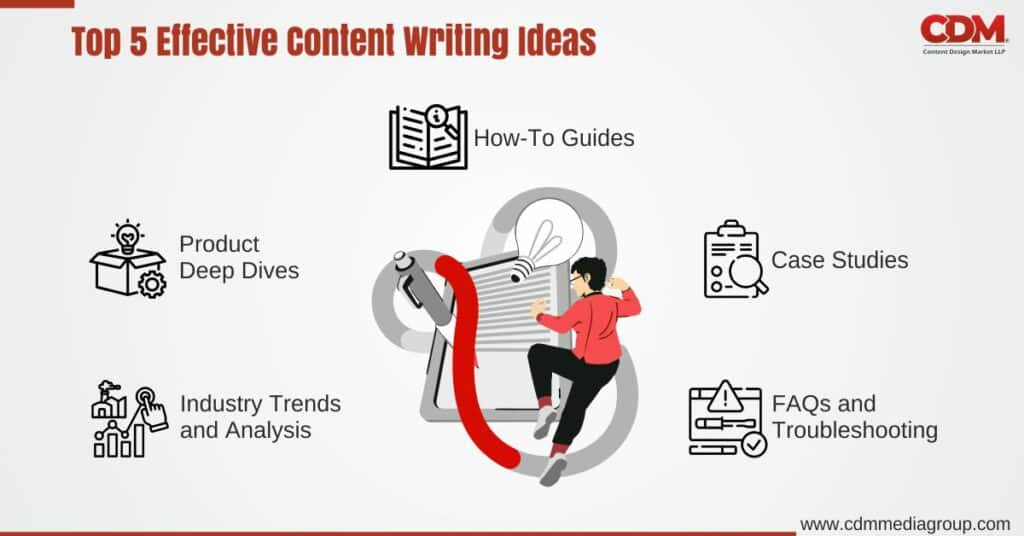Table of Content
| 1. How-To Guides |
| 2. Product Deep Dives |
| 3. Industry Trends and Analysis |
| 4. Case Studies |
| 5. FAQs and Troubleshooting |
| 6. Comparisons and Reviews |
| 7. Behind-the-Scenes |
| 8. Industry Standards and Best Practices |
| 9. Webinars and Video Tutorials |
| 10. Infographics and Visual Content |
Effective writing has emerged as a key strategy for increasing awareness and reaching a larger audience in the highly competitive business landscape. Technical content writing that resonates with your target audience establishes your expertise and boosts your business visibility. Create in-depth blog posts addressing industry challenges, trends, and solutions. For instance, if your business operates in the cybersecurity sector, write about the latest threats and innovative defense strategies. According to recent studies, companies that publish blog content regularly receive 97% more inbound links, significantly improving their search engine rankings.
Additionally, leverage the power of multimedia by incorporating infographics, videos, and webinars to make complex technical topics more accessible. Sharing such content on social media platforms can amplify your reach, as social media users are 40% more likely to share visual content. By consistently producing high-quality technical content and promoting it strategically, your business can establish thought leadership, build trust, and enhance its online visibility in the competitive market. Here are 10 simple yet effective technical content writing ideas to captivate your audience and elevate your business visibility.
How-To Guides

Create step-by-step guides addressing common challenges in your industry. Whether it’s troubleshooting, installation procedures, or optimization tips, providing valuable insights will position your business as an authority in the field. To create a compelling and user-friendly guide, thoroughly understand your audience and their proficiency levels. Define the guide’s goals and objectives precisely, making sure that users of all levels can benefit from it. Use a logical and sequential structure, breaking down the process into manageable steps. Employ a consistent and concise writing style, avoiding jargon whenever possible. Incorporate visuals, such as screenshots, diagrams, or videos, to enhance comprehension. Ensure that each step is accompanied by clear and actionable instructions, leaving no room for ambiguity.
Product Deep Dives
These deep dives offer a detailed understanding of the product’s architecture, design principles, and integration within broader technological ecosystems. Technical writers may delve into the product’s features, performance metrics, compatibility with other technologies, and potential use cases. The documentation may also include step-by-step guides, troubleshooting tips, and best practices to assist users in maximizing the product’s utility. Through product deep dives, technical writers aim to provide a valuable resource for novice and advanced users, fostering a deeper appreciation and proficiency in utilizing the product effectively within technical environments.
Industry Trends and Analysis
Stay ahead of the curve by writing about emerging trends and providing insightful analyses. Discuss the implications of these trends on your industry, offering your audience a valuable perspective. Employing data-driven methodologies and statistical models, this technical document elucidates the quantitative aspects of market trends, offering stakeholders a precise understanding of growth trajectories, market share dynamics, and competitive landscapes. Furthermore, it incorporates qualitative insights by dissecting key factors influencing industry evolution, regulatory landscapes, and the impact of technological innovation. By using a methodical and analytical approach, this research seeks to provide professionals and decision-makers with the knowledge necessary to successfully navigate the challenging landscape of industry trends and position their initiatives for long-term success.
Case Studies
When interacting with potential customers, real-life examples of how your products or services have benefited clients work wonderfully. Case studies demonstrate your capabilities and foster trust with potential customers. These examples serve as invaluable instruments for presenting empirical evidence, illustrating problem-solving approaches, and highlighting the tangible benefits of a particular technology or methodology. Through meticulous documentation, technical writers can break down intricate details, methodologies, and outcomes, providing readers with a clear understanding of how a solution functions in practical situations. By delving into case studies, technical writers not only elucidate their subject matter but also offer a bridge between technical intricacies and real-world applications, fostering a deeper comprehension among their target audience.
FAQs and Troubleshooting
Predicting queries from users and offering concise, informative answers to frequent problems are key components of effective FAQs. Additionally, troubleshooting guides delve into the intricacies of problem-solving, offering step-by-step solutions and diagnostics for more intricate issues. As an overarching discipline, technical writing encompasses creating these materials and extends to comprehensive documentation, user manuals, and guides. It involves translating complex technical information into user-friendly content, ensuring end-users can easily comprehend and apply the information provided. Through a harmonious blend of FAQs, troubleshooting guides, and meticulous technical writing, businesses can empower users to navigate technological landscapes with confidence and proficiency.
Comparisons and Reviews
Write detailed comparisons between your products/services and those of competitors. A comprehensive product comparison entails a meticulous examination of multiple offerings in the market, objectively weighing their pros and cons. Utilizing technical specifications and performance metrics, these analyses provide readers with a clear understanding of how products stack up against each other. Technical review writing involves systematically evaluating a product and diving into its design, engineering, and user experience. This form of content is characterized by precise terminology, data-driven assessments, and a focus on the technical aspects that matter most to the target audience. By employing a technical lens in product comparisons and reviews, businesses can cater to a more discerning audience seeking in-depth insights to make informed decisions.
Behind-the-Scenes
Offer a glimpse into the inner workings of your business. Share stories about your team, showcase your workplace, or provide insight into your product development process. This documentation goes beyond the surface, providing a detailed analysis of the algorithms, coding structures, and interactions that make a product or system operate seamlessly. Whether it’s unveiling a software application’s architecture, the hardware component’s inner workings, or the complex process’s intricacies, technical writing clarifies technology’s often intricate and convoluted aspects. By adopting a behind-the-scenes approach in technical documentation, writers empower users, developers, and stakeholders with the knowledge to navigate and optimize these systems effectively. Humanizing your brand fosters a deeper connection with your audience.
Industry Standards and Best Practices
Educate your audience on industry standards and best practices. Break down complex technical jargon into digestible content, making it accessible to a diverse audience. Additionally, it delves into best practices, providing practical insights and expert recommendations that can enhance performance and mitigate risks. Utilize clear and concise language, accompanied by visual aids such as diagrams and charts, to elucidate complex processes or methodologies. Whether you’re addressing coding standards, engineering protocols, or quality assurance procedures, technical writing on industry standards and best practices is a valuable resource for professionals seeking guidance in an ever-evolving landscape. By becoming a trusted source of information, your technical content can establish your authority within the industry and contribute to advancing best practices.
Webinars and Video Tutorials

Enhance your content by incorporating webinars or video tutorials. Webinars provide a live, interactive platform to engage with your audience, offering in-depth discussions on complex technical topics. These sessions can facilitate real-time Q&A sessions, fostering a sense of community and addressing specific concerns. Video tutorials, on the other hand, offer a visual, step-by-step guide to help users navigate intricate processes or understand complex concepts. Combining these two mediums enables a comprehensive approach to technical communication, catering to diverse learning styles. Ensure your content is concise, clear, and well-structured, providing valuable insights that empower your audience. By embracing webinars and video tutorials, you enhance your technical writing and establish your expertise in the field, building trust among your audience.
Infographics and Visual Content
Create visually appealing infographics that break down complex information into easily digestible segments. Diagrams, flowcharts, and graphs simplify complex processes and give readers a quick overview. Additionally, incorporating color schemes and design elements in technical documentation can enhance user engagement and make information more accessible. As attention spans decrease in the digital age, the judicious use of infographics and visual content facilitates better understanding. It ensures that technical details are both user-friendly and aesthetically pleasing, ultimately elevating the overall quality and effectiveness of technical writing.
In conclusion, incorporating these 10 technical content writing concepts into your approach can boost your company’s visibility and build your brand as an industry go-to resource. To maximize the impact of your material, maintain consistency, monitor engagement, and adjust your approach as appropriate.
Ready to Take Your Business to the Next Level? Explore our comprehensive technical content writing solutions!
At CDM, we specialize in Content Marketing Services. Discover the full potential of your technical content writing services. Contact us today for a personalized consultation, and let us navigate your path toward enhanced visibility and success together!




